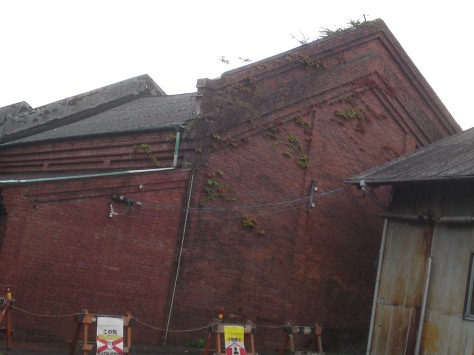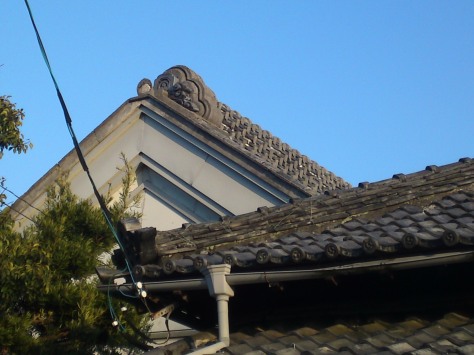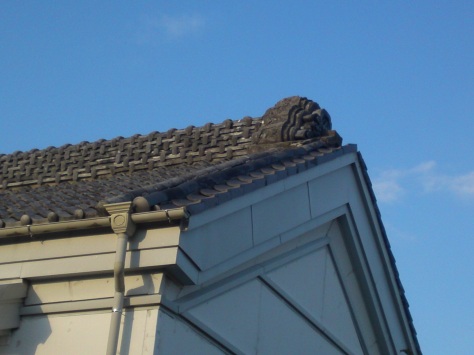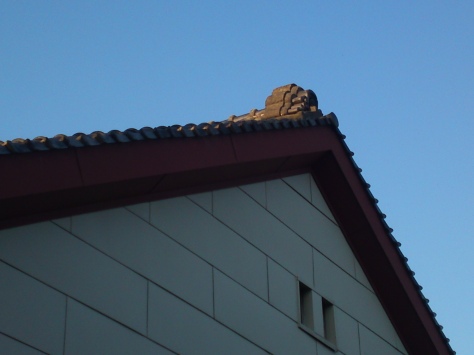Kura: Traditional Warehouses in Shizuoka Prefecture 41: Honkaku Temple 8(本覚寺) in Ikeda, Suruga Ku, Shizuoka City!
“Kura” (in Japanese 蔵 or 倉) means “warehouse” or “Storehouse”.
In traditional Japan, especially during the Edo Era, as most of buildings and urba/village structures were made of wood, fires were the bane of society by and large.
However well-protected a fire would consume a house or buildings and all its properties within minutes.
Hence a special building or warehouse was needed to protect goods and properties against such a catastrophe.
But erecting a storehouse solely made of concrete, stones and some metal cost a vast amount of silver and gold and only rich merchants and nobility could afford them. Even castles could not be built entirely of stone then.
The other having some time on my hands I decided to cycle down to Ikeda in Suruga Ku, south of Shizuoka JR Station to look for a kura that had just been introduced to me by my good friend, Philip Kreiner.
It is an old Buddhist Temple dating back to 1307 during the Kamakura Era.
The monk there kindly explained me that the kura had been built in the 2nd Year of Meiji Era (1869) after a great fire destroyed the biggest part of the Temple to preserve precious documents although nowadays it is used only as a shed.
Although comparatively small it looked different from the usual kura built by rich merchants or high officials.
It had an unusual portico at its entrance with typical Buddhist Temple decoration.
It even bore its own mon/Japanese crest!
it was in excellent repair in spite of the large smudges caused by rain running down the roofed portico.
The alignment pegs were in a very straight line proving that the building was not suffering from any warping!
Old but very solid window panels and awning!
That door seemed very solid, too!
It was open on both sides for better draft.
Well-maintained tiled roof pinion!
Well-maintained and grilled openings to let the water flow under the building!
Walking around the building…
Well-maintained on any side!
Interesting discovery, all in all!
——————
Kura: Traditional Warehouses in Shizuoka Prefecture 40: Edo Era Village Kura in Nakajima Elementary School, Suruga Ku, Shizuoka City!
“Kura” (in Japanese 蔵 or 倉) means “warehouse” or “Storehouse”.
In traditional Japan, especially during the Edo Era, as most of buildings and urba/village structures were made of wood, fires were the bane of society by and large.
However well-protected a fire would consume a house or buildings and all its properties within minutes.
Hence a special building or warehouse was needed to protect goods and properties against such a catastrophe.
But erecting a storehouse solely made of concrete, stones and some metal cost a vast amount of silver and gold and only rich merchants and nobility could afford them. Even castles could not be built entirely of stone then.
Yesterday I was cycling in Nakajima District in Suruga Ku, that the part of of Shizuoka City south of Shizuoka JR Station, an area I still have a lot to learn about in spite of my living in Shizuoka City for 40 years!
Veering into of the straight streets going south I found myself cycling past Nakajima Elementary School.
That is when I espied a rare site beyond the School Disaster Evacuation sign!
A small and very old, but splendidly preserved with little or no repairs standing on the grounds of an elementary school!
I had to investigate!
Simple but stolid enough!
Thanks to this welcome sign I learned it had been built in Edo Era to serve as a warehouse for Nakajima Village as the area was called then. It served mainly as a warehouse for all important documents concerning the Village.
The Elementary School was built by it only many years later.
Apparently it is the only one of its kind in Shizuoka City!
It was wholly built with uncut or cut stones!
It was also located so as toe let the prevailing winds provide needed draft through the two windows opened at each extremity!
I should come back to take a picture of it with cherry tree in blooms!
Do you notice the opening at its base?
This is to make sure that any water accumulated between the high foundation and the kura can be expelled quickly and to insure the same area stays dry!
With the modern elementary school buildings in the background!
The roofing is in good repair!
The pinion with “水/mizu/water” carved in!
Tiled roof details!
How old are the wooden eaves?
How many schoolchildren has this window seen walk past under it?
The door, although repainted, seems original enough!
Only one of the alignment “pegs” was missing!
it was too late in the day to talk with the staff, but I certainly intend to interview the schoolmaster someday!
————————————————
Kura: Traditional Japanese Warehouses in Shizuoka Prefecture 39: Katsuyama Family Home in Kawane Cho, Shimada City!
“Kura” (in Japanese 蔵 or 倉) means “warehouse” or “Storehouse”.
In traditional Japan, especially during the Edo Era, as most of buildings and urba/village structures were made of wood, fires were the bane of society by and large.
However well-protected a fire would consume a house or buildings and all its properties within minutes.
Hence a special building or warehouse was needed to protect goods and properties against such a catastrophe.
But erecting a storehouse solely made of concrete, stones and some metal cost a vast amount of silver and gold and only rich merchants and nobility could afford them. Even castles could not be built entirely of stone then.
The other my good friend Mr. Osamu Kurosawa/黒沢修さん, a respected historian in our Prefecture took me to a house hidden in Kawane-Cho, not far from Ieyama, in Shimada City, to show me a splendid kura!
Actually, the kura is only one building inside a vast property owned by the same family for hundred of years.
You must remember that in Edo Era, Shimada City was one of the most important cities in the whole Central Japan because it was a border City by the Ooi River controlling all traffic between Edo/Tokyo and Osaka!
the name of the family owning the vast property is Katsuyama/勝山!
Any rich landowner or person of great importance lived in a large house with servants quarters and a kura to store and protect rice and valuables in particular against fires and natural disasters!
The lady we met inside the house first kindly agree to let me take photographs of the warehouse under the gentle request of my friend, Osamu!
Actually the kura has just been restored by its owner as you can see with the perfectly working windows!
It actually took him more than a year to complete the job!
The “pegs” are still properly aligned, meaning that the walls haven’t been affected by the depredations of time!
The whole property ought to be used as a locale for historical movies or TV programs!
Actually it should designated as a cultural asset and it should be the government’s task and duty to look after it!
The pegs and metal links with the upper roof are still in great repair, meaning the uper roof is stable!
This is the first time I see such a big “oni gara/goblin pinion tile”! That only should become a cultural asset!
A closer view at the upstairs window!
The roofing must be hard to maintain in good repair!
A “rear” view!
The other “oni gara”!
The door and lock dating back from the Edo period!
Heavy door panels had to be pulled in to close the door!
Taken back to another era!
I marveled at how it can have been preserved!
The ancient “namako” design also is a good enough reason to designate it as a cultural asset as very recently even the Government was heard moaning about their disappearance! In fact, it is the first time I saw a pillar decorated in “namako” design!
Actually the lower roof angle had to be propped up!
——————————————————————–
KURA: Traditional Japanese Warehouses in Shizuoka Prefecture 28: “Reformed” Kura in Mishima City!

“Kura” (in Japanese 蔵 or 倉) means “warehouse” or “Storehouse”.
In traditional Japan, especially during the Edo Era, as most of buildings and urba/village structures were made of wood, fires were the bane of society by and large.
However well-protected a fire would consume a house or buildings and all its properties within minutes.
Hence a special building or warehouse was needed to protect goods and properties against such a catastrophe.
But erecting a storehouse solely made of concrete, stones and some metal cost a vast amount of silver and gold and only rich merchants and nobility could afford them. Even castles could not be built entirely of stone then.

Whereas the bigger kura are very often maintained by rich individuals or local government these days, some smaller ones are sometimes “reformed/adapted” with various success.
I found the\is one the other day in Mishima City ensconced between newly developed touristic spots!

The very old windows and doors were left as they were.

It looked like a real house from a distance!

The original owner(s) didn’t that rich, though!

It seems to being used as a storeroom or some kind of atelier!

With a little effort and more decoration it could be turned into romantic spot at night?

For all the corrugated iron it seems very solid as the alignment hooks seem in the right position!

At least it must be very dry inside as the roof is in good repair!
————————————————
Kura: Traditional Japanese warehouses in Shizuoka Prefecture 24: Shimada City, Tochiyama

“Kura” (in Japanese 蔵 or 倉) means “warehouse” or “Storehouse”.
In traditional Japan, especially during the Edo Era, as most of buildings and urba/village structures were made of wood, fires were the bane of society by and large.
However well-protected a fire would consume a house or buildings and all its properties within minutes.
Hence a special building or warehouse was needed to protect goods and properties against such a catastrophe.
But erecting a storehouse solely made of concrete, stones and some metal cost a vast amount of silver and gold and only rich merchants and nobility could afford them. Even castles could not be built entirely of stone then.
If you get off at Rokugo JR Station (六合駅) and walk towards Shimada City you will discover two kuras before you reach the Tochiyama Bridge (栃山橋) over theOotsuya River (大津谷川).
The Tochiyama Bridge (栃山橋)
You will find the first not halfway from Rokugo Station!
It is standing beside a very large traditional Japanese house which seems unoccupied but the kura itself is in good repair and obviously used by local farmers. It must have been owned by the former rich owners of the house.
The windows were kept open, a sure sign of use!
Back view.
All the walls and roof are in very good repair.
Side view.
Front angled view.
Unfortunately it was very difficult to access.
Very little space between the door and the house!
Beautiful pinion!
Well maintained rain drainage!
I really wished I could have gone inside!
You will find the second one your left just before the bridge!
Very old and slightly derelict it is still very much in use!
It is comparatively very big with a lot of roofing!
It certainly needs a good scrub and re-plastering!
Very long!
I suspect it is being used as a warehouse by local tea growers!
Only the back has been clearly repaired!
Mind you, the whole edifice still looks very very strong!
The original pinion is still there!
I’ve always wondered what these contraptions are for!
————————————–
KURA: Traditional Japanese Warehouses in Shizuoka Prefecture 25: Shimada City, Yokoi Factory

“Kura” (in Japanese 蔵 or 倉) means “warehouse” or “Storehouse”.
In traditional Japan, especially during the Edo Era, as most of buildings and urba/village structures were made of wood, fires were the bane of society by and large.
However well-protected a fire would consume a house or buildings and all its properties within minutes.
Hence a special building or warehouse was needed to protect goods and properties against such a catastrophe.
But erecting a storehouse solely made of concrete, stones and some metal cost a vast amount of silver and gold and only rich merchants and nobility could afford them. Even castles could not be built entirely of stone then.

The other day I was exploring the south side of Shimada City when I discovered this enormous red brick kura near the Shimada Baseball Stadium.
As it was obviously part of a bigger complex I decided to investigate in earnest!

I walked around it for a few pictures first!
With all that ivy contrasting on the red bricks I could easily imagine a movie being enacted nearby!

Ivy!

The windows must have been locked for quite some time!

Apparently the ivy was not growing at that end…

It certainly looked old.
Red brick kuras are rare in Shizuoka Prefecture!

I finally reached the entrance to the normous complex where the kura was located.
It all belonged to the Yokoi Factory of Tokushu Tokai Seishi Kabushiki Kaisha (Special Tkai Paper Company)!

It was a Saturday and the company was closed, but the guard kindly informed me that the Kura, although presently unused due to its bad state, dated back to 90 years ago. He also old me that the original wooden office building of the same period could be found inside the complex.
He was also kind enough to tell me to come back on a week day when I could get official permission to visit it!

The kura from inside the company grounds.

It is completely locked out because of risks of collapse!

Looking forward to the “official” visit!
————————————-
KURA: Traditional Japanese Warehouses in Shizuoka Prefecture 25: Shimada City, near baseball Stadium

“Kura” (in Japanese 蔵 or 倉) means “warehouse” or “Storehouse”.
In traditional Japan, especially during the Edo Era, as most of buildings and urba/village structures were made of wood, fires were the bane of society by and large.
However well-protected a fire would consume a house or buildings and all its properties within minutes.
Hence a special building or warehouse was needed to protect goods and properties against such a catastrophe.
But erecting a storehouse solely made of concrete, stones and some metal cost a vast amount of silver and gold and only rich merchants and nobility could afford them. Even castles could not be built entirely of stone then.

The other day, as I was exploring the south side of Shimada City JR Railway Station I discovered another kura, white this time, just standing next to Ykoi Factory and its enormous red-brick warehouse!

By individual home standards the two-storey kura was big!

The ancient door is still in good functional state!

Actually it has two main doors, a bit unusual fact which probably means the inside is divided into two distinct rooms.

For all its apparent grime, the building is very sound as shown by the straight alignment of the “hooks”!

I would say it is still used as a large farm equipment shed!
—————————————-
KURA: Traditional Japanese Warehouses in Shizuoka Prefecture 27: Akino Family House in Shimada City!

“Kura” (in Japanese 蔵 or 倉) means “warehouse” or “Storehouse”.
In traditional Japan, especially during the Edo Era, as most of buildings and urba/village structures were made of wood, fires were the bane of society by and large.
However well-protected a fire would consume a house or buildings and all its properties within minutes.
Hence a special building or warehouse was needed to protect goods and properties against such a catastrophe.
But erecting a storehouse solely made of concrete, stones and some metal cost a vast amount of silver and gold and only rich merchants and nobility could afford them. Even castles could not be built entirely of stone then.

the other day I noticed a kura hidden inside a big property and s\decided to investigate!
The whole property was locked up and unfortunately access and views were very limited in spite of its splendid state!

I decided to find the entrance of the property where I found this commemorative pillar erected beside the entrance gate!
It stated that this home erected during the Meiji Era was owned by the Akino Family and had been designated as a national Cultural Asset in 1935!

Beside the very door hung this name plate with name of Akino Family and a rare kind of Arms representing agricultural tools! The Arms were evidently inspired by those of noble families in Europe!
I found out later that the Akin Family was probably the richest and the most powerful family in Edo Period and beyond in Shimada City which was then one of the richest cities in the Prefecture!
Unfortunately in spite of its status as a Cultural Asset it is uninhabited and closed to the public although local politicians are fighting to have it open as a local Museum!

What I found hidden behind all manners of vegetation was not one but a double imposing kura!
I was told there was even a third one hidden by trees inside the promises!
The family must have been enormously rich!

Still in incredibly good state and repair!

Unusually tall walls with their alignment hooks still unmoved or unbent!
I was told the kura contained an incredible wealth of documents and what else!

A shame we can see only a glimpse of it all!

The double kura from the back!

All windows safely barred!

Splendid roofing!

It is good-by for the moment but I sincerely hope that one day I will be allowed to discover all that is hidden behind these trees!












































































